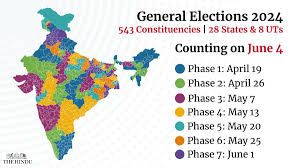Decoding Indian Party Symbols: Insights into Their Origins and Meaningful Significance for the 2024 General Elections

Credit : The Hindu News
19.04.2024 : As the fervor of the 2024 General Elections engulfs the nation, understanding the historical roots and symbolic meanings behind the election emblems of various Indian political parties becomes paramount. From the iconic bicycle symbol of the Telugu Desam Party (TDP) in Vijayawada’s Kristurajupuram to the striking sight of Azad Samaj Party (Kanshi Ram) supporters carrying large kettles in Western Uttar Pradesh’s Nagina, these symbols are not just visual representations but embodiments of political legacies and ideologies.
Since the inception of the electoral process in 1951, where a multitude of parties vied for approximately 4,500 seats across the Lok Sabha and State Assemblies, the Election Commission of India has played a pivotal role in assigning symbols to parties. This practice gained formal structure with the implementation of The Election Symbols (Reservation and Allotment) Order of 1968, which standardized the allocation of symbols to parties at both national and state levels, as well as to independent candidates. Furthermore, this order contains provisions for scenarios such as party mergers or splits, ensuring continuity and clarity in symbol allotment.
As we delve into the origins of these symbols, we uncover a tapestry of history, culture, and political ethos. The bicycle, synonymous with the TDP, reflects a narrative of progress, mobility, and grassroots connection—a testament to the party’s roots in championing rural development and connectivity. Contrastingly, the imagery of large kettles carried by Azad Samaj Party supporters speaks to themes of community, sustenance, and solidarity—a visual metaphor for their commitment to social welfare and inclusivity.
Beyond their aesthetic appeal, these symbols serve as powerful communication tools, resonating with voters on emotional and ideological levels. They encapsulate a party’s core values, aspirations, and promises, making them indispensable elements of India’s vibrant electoral landscape.
As we navigate the intricate web of party symbols during this election season, let us not only decode their visual language but also appreciate the narratives they weave—the stories of resilience, vision, and the democratic spirit that define India’s electoral journey.

